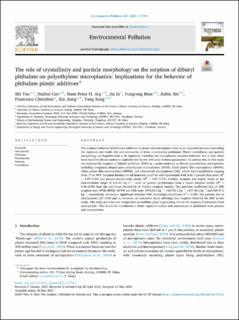| dc.description.abstract | The sorption behavior of phthalate additives in plastic and microplastic litter is an important process controlling the exposure, net health risk and ecotoxicity of these co-occurring pollutants. Plastic crystallinity and particle morphology are hypothesized to be important variables for microplastics sorption behavior, but to date there have been few direct studies to explicitly test for the influence of these parameters. To address this, in this study we explored the sorption of dibutyl phthalate (DBP) as a probe molecule to diverse polyethylene microplastics including irregularly-shaped pure polyethylene microplastics (IPPM), black plastic film microplastics (BPFM), white plastic film microplastics (WPFM), and commercial microspheres (CM), which had crystallinities ranging from 17 to 99%. Sorption kinetics for all materials could be well represented with both a pseudo-first-order (R2 = 0.87–0.93) and pseudo-second-order model (R2 = 0.87–0.93). Further, sorption was highly linear in the concentration range of 0.5–10 mg L−1, with no greater performance from a linear sorption model (R2 = 0.96–0.99) than the non-linear Freundlich or Temkin sorption models. The partition coefficient (Kd) of DBP sorption onto IPPM, BPFM, WPFM and CMs were 1974.55 L kg−1, 1483.85 L kg−1, 1477.45 L kg−1 and 509.37 L kg−1, respectively, showing a significant decrease with increasing crystallinity (r2 = 0.98). The particle size of microplastics (27–1000 μm) is, however, an indecisive factor affecting their sorption behavior for DBP in this study. This study provides new insight that crystallinity plays a governing role on the sorption of phthalate from microplastic. This should be considered in future exposure studies and assessments of phthalates from plastics and microplastics. | en_US |

